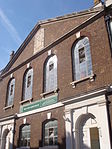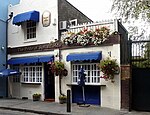Freedom for Humanity
Freedom for Humanity was a temporary mural by the American artist Mear One (Kalen Ockerman), painted on a wall in Hanbury Street in the London Borough of Tower Hamlets in mid-September 2012. It depicted men wearing business suits seated aside bent-over naked figures who formed a table while playing a Monopoly-like board game that rested on the naked figures' backs. Overseeing the scene is an Eye of Providence surrounded by images of industry and protest. The mural was criticized for using anti-semitic tropes and imagery including stereotypical depictions of Jews, references to finance and the monetary and Masonic associations of the Eye of Providence. The artist himself, Mear One, has said that "My mural is about class and privilege. The banker group is made up of Jewish and white Anglos,".
Excerpt from the Wikipedia article Freedom for Humanity (License: CC BY-SA 3.0, Authors).Freedom for Humanity
Brick Lane, London Whitechapel
Geographical coordinates (GPS) Address Nearby Places Show on map
Geographical coordinates (GPS)
| Latitude | Longitude |
|---|---|
| N 51.520333333333 ° | E -0.071638888888889 ° |
Address
enso
Brick Lane 124-126
E1 6RU London, Whitechapel
England, United Kingdom
Open on Google Maps










